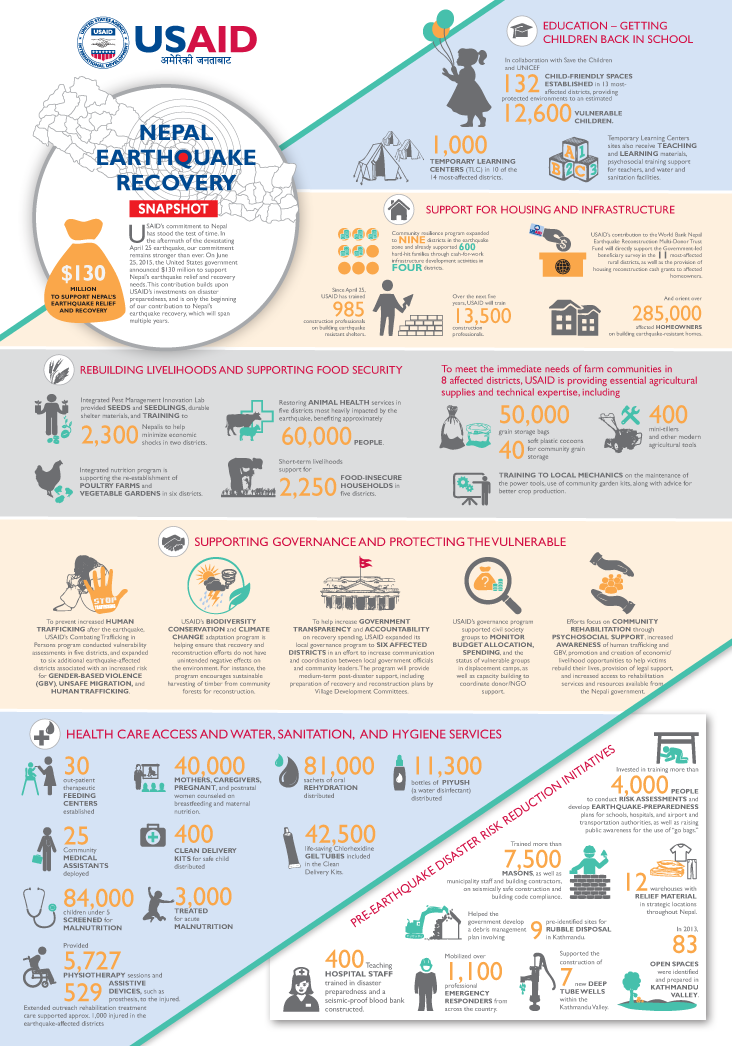
$130 MILLION TO SUPPORT NEPAL’S EARTHQUAKE RELIEF AND RECOVERY
USAID’s commitment to Nepal has stood the test of time. In the aftermath of the devastating April 25 earthquake, our commitment remains stronger than ever. On June 25, 2015, the United States government announced $130 million to support Nepal’s earthquake relief and recovery needs. This contribution builds upon USAID’s investments on disaster preparedness, and is only the beginning of our contribution to Nepal’s earthquake recovery, which will span multiple years.
Education - Getting Children Back in School
In collaboration with Save the Children and UNICEF, 132 child-friendly spaces established in 13 most-affected districts, providing protected environments to an estimated 12,600 vulnerable children. 1,000 temporary learning centers (TLC) in 10 of the 14 most-affected districts.
Temporary Learning Centers sites also receive teaching and learning materials, psychosocial training support for teachers, and water and sanitation facilities.
Support for Housing and Infrastructure
Community resilience program expanded to nine districts in the earthquake zone and already supported 600 hard-hit families through cash-for-work infrastructure development activities in four districts.
USAID’s contribution to the World Bank Nepal Earthquake Reconstruction Multi-Donor Trust Fund will directly support the Government-led beneficiary survey in the 11 most-affected rural districts, as well as the provision of housing reconstruction cash grants to affected homeowners.
Since April 25, USAID has trained 985 construction professionals on building earthquake resistant shelters.
Over the next five years, USAID will train 13,500 construction professionals.
And orient over 285,000 affected HOMEOWNERS on building earthquake-resistant homes.
Rebuilding Livelihoods and Supporting Food Security
To meet the immediate needs of farm communities in 8 affected districts, USAID is providing essential agricultural supplies and technical expertise, including 50,000 grain storage bags, 400 mini-tillers and other modern agricultural tools, and 40 soft plastic cocoons for community grain storage
Integrated Pest Management Innovation Lab provided SEEDS and SEEDLINGS, durable shelter materials, and TRAINING to Nepalis to help 2,300 minimize economic shocks in two districts.
Restoring ANIMAL HEALTH services in five districts most heavily impacted by the earthquake, benefiting approximately 60,000 PEOPLE.
Integrated nutrition program is supporting the re-establishment of POULTRY FARMS and VEGETABLE GARDENS in six districts
Short-term livelihoods support for FOOD-INSECURE 2,250 HOUSEHOLDS in five districts.
TRAINING TO LOCAL MECHANICS on the maintenance of the power tools, use of community garden kits, along with advice for better crop production.
Supporting Governance and Protecting the Vulnerable
To prevent increased HUMAN TRAFFICKING after the earthquake, USAID’s Combating Trafficking in Persons program conducted vulnerability assessments in five districts, and expanded to six additional earthquake-affected districts associated with an increased risk for GENDER-BASED VIOLENCE (GBV), UNSAFE MIGRATION, and HUMAN TRAFFICKING.
USAID’s BIODIVERSITY CONSERVATION and CLIMATE CHANGE adaptation program is helping ensure that recovery and reconstruction efforts do not have unintended negative effects on the environment. For instance, the program encourages sustainable harvesting of timber from community forests for reconstruction.
To help increase GOVERNMENT TRANSPARENCY and ACCOUNTABILITY on recovery spending, USAID expanded its local governance program to SIX AFFECTED DISTRICTS in an effort to increase communication and coordination between local government officials and community leaders. The program will provide medium-term post-disaster support, including preparation of recovery and reconstruction plans by Village Development Committees.
USAID’s governance program supported civil society groups to MONITOR BUDGET ALLOCATION, SPENDING, and the status of vulnerable groups in displacement camps, as well as capacity building to coordinate donor/NGO support.
Efforts focus on COMMUNITY REHABILITATION through PSYCHOSOCIAL SUPPORT, increased AWARENESS of human trafficking and GBV, promotion and creation of economic/ livelihood opportunities to help victims rebuild their lives, provision of legal support, and increased access to rehabilitation services and resources available from the Nepali government.
Health Care Access and Water, Sanitation, and Hygeine Services
30 out-patient therapeutic feeding centers established
40,000 mothers, caregivers, pregnant, and postnatal women counseled on breastfeeding and maternal nutrition
81,000 sachets of oral rehydration distributed
11,300 bottles of piyush (a water disinfectant) distributed
25 community medical assistants deployed
400 Clean Delivery Kits for safe child distributed
42,500 life-saving Chlorhexidine gel tubes included in the Clean Delivery Kits
84,000 children under 5 screened for malnutrition
3,000 treated for acute malnutrition
Provided 5,727 physiotherapy sessions and assistive devices, such as prosthetics, to the injured. Extended outreach rehabilitation treatment care supported approximately 1,000 injured in the earthquake-affected districts.
Pre-Earthquake Disaster Risk Reduction Initiatives
PEOPLE Invested in training more than 4,000 people to conduct RISK ASSESSMENTS and develop EARTHQUAKE-PREPAREDNESS plans for schools, hospitals, and airport and transportation authorities, as well as raising public awareness for the use of “go bags"
Trained more than 7,500 MASONS, as well as municipality staff and building contractors, on seismically safe construction and building code compliance
12 warehouses with relief material in strategic locations throughout Nepal.
Helped the government develop a debris management plan involving 9 pre-identified sites for rubble disposal in Kathmandu
400 Teaching Hospital staff trained in disaster preparedness and a seismic-proof blood bank constructed.
Mobilized over 1,100 professional emergency responders from across the country.
Supported the construction of 7 new deep tube wells within the Kathmandu Valley
In 2013, open spaces were identified and prepared in Kathmandu Valley.







Comment
Make a general inquiry or suggest an improvement.